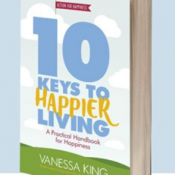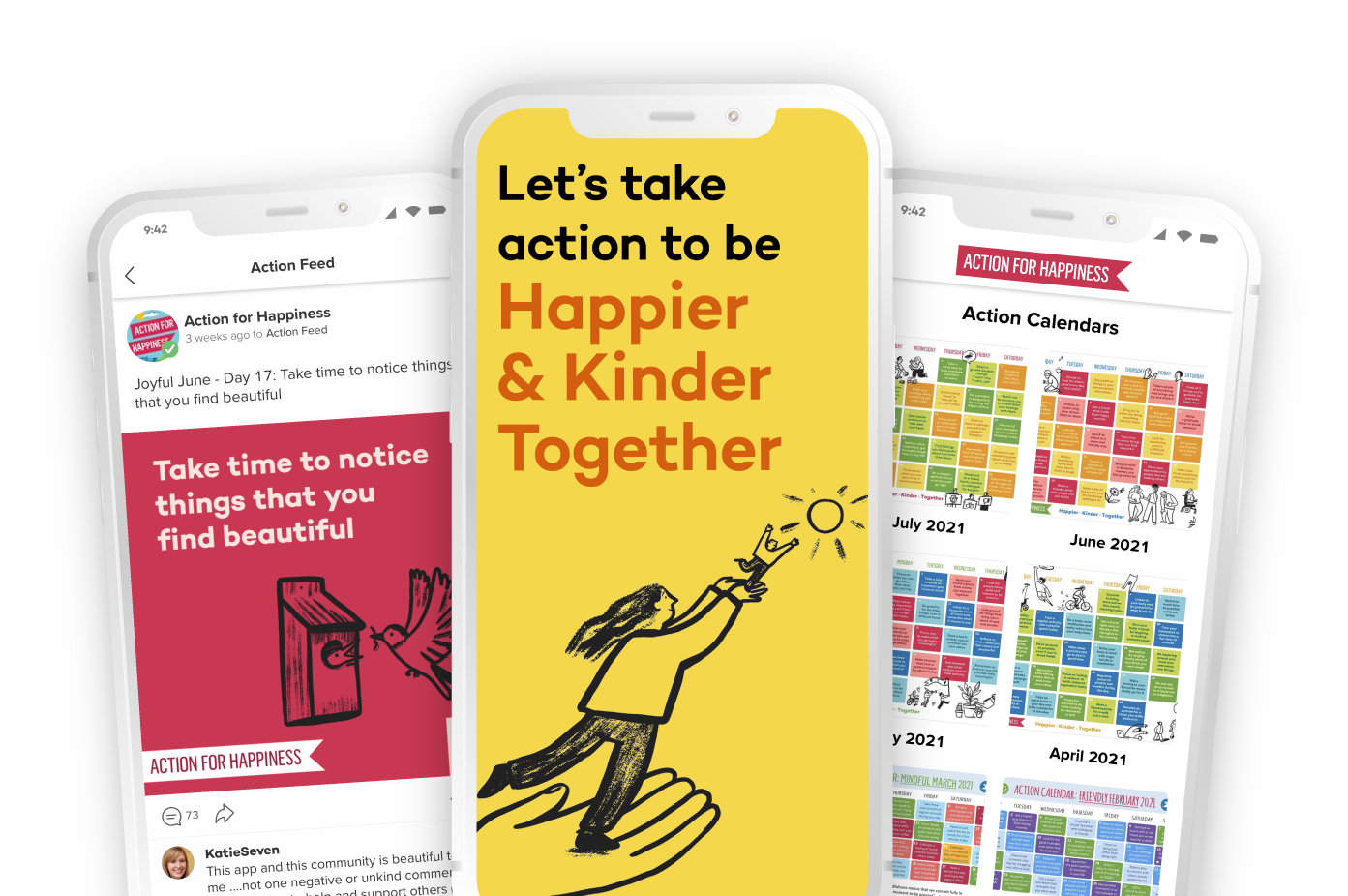Direction
Have goals to look forward to
How we feel and think about the future and how we work towards it can make a difference for our happiness in the present.
Having a sense of direction, optimism and hope can all contribute to feeling happier [1].
An optimistic or hopeful outlook means we are more likely to experience positive emotions, feel more confident, have higher satisfaction with life, have better physical health and are less likely to be depressed [2]. We are also more likely to take care of ourselves physically and persist with medical treatments [3]. Of course, we need to be realistic, but hope and optimism both contribute to our resilience too, helping us cope with tough times, approach relationship issues constructively, take a more active, solution-focused approach to deal with problems and be more likely to reach out for support from others [4].
Finding and working towards meaningful goals is a way of connecting the present to our future and research is showing how it can boost our happiness and wellbeing too [5].
Although our personality or circumstances might orient us towards seeing the future more positively or more negatively, science shows there are future-focused, practical actions we can take that can contribute to how happy we feel now.
Visit our goal setting page for a step-by-step guide on how to set your goals.
Why not take action right now? Join Abi, our coach from the 10 Days of Happiness program, for a short video and a quick activity to help you move towards the things that matter.
Optimism
Being optimistic means having a positive outlook on life, both in good times and when we face difficulties and challenges. When we are optimistic we generally expect the future will turn out well and that we can achieve what we set out to do [6]. Being optimistic isn’t about being unrealistic, but seeing the glass as half-full rather than half-empty. It's also not about taking risks in very dangerous situations when it pays to err on the side of caution.
Optimism is strongly associated with experiencing positive emotions, better coping in stressful situations, fewer mental and physical ill-health symptoms and increased motivation and effort [7]. Whilst some people naturally have an optimistic outlook, research shows even if we don’t, there are actions we can take to cultivate one [8]. These may also help by reducing unhappiness, depression and even pain, as well as boosting other feel-good emotions [9]. Taking action to cultivate a sense of optimism can be helpful in the short term, for example in the face of challenges and may have benefits longer-term [10].
Try it: On each of the next four days take a minute to imagine your life in the future, at a time frame that makes sense to you (e.g. 6 months, a year or 5 years). Imagine that everything has turned out as well as it possibly could. You’ve worked hard and any challenging circumstances have changed just enough to enable this best possible life to happen. Then spend 20 minutes writing freely about this best possible life. Describe all the different aspects of your best possible life in as much detail as you can [11]. After you have completed this activity, write a letter to yourself now from your future self with advice on the steps you might take to start to move towards the future you imagined [12].
Try it: Two to three times a week over the next three week, reflect back on the previous few days and list five things (however small) that helped you feel that life is enjoyable, enriching and/or worthwhile and three things that could help you see the bright side of a difficult situation [13].


Hope
Hope is a positive motivational force that can keep us going through difficulties and help us overcome obstacles and challenges that we encounter as we work towards achieving our goals. It’s related to optimism but goes beyond simply feeling positive about the future by being more specific about our expectations and includes thoughts and beliefs about how we might achieve these [14].
The most well-known psychological approach to hope has three components: What we specifically hope for (our goal), the motivation or energy we have to get started and sustain working towards that, and ‘pathways thinking’ – the paths we’ll take to achieve our goals and the belief that we can find ways around obstacles that inevitably will get in the way. We can enhance our motivation by selecting meaningful and intrinsically interesting goals [15]. Anticipating the steps we plan to take, what obstacles might get in our way, and how we’ll get around these all increase the likelihood of reaching what we set out to do [16].
Hopeful thinking in this way has been shown to relate to higher performance in education and sports, improved relationships, and greater physical and psychological wellbeing [17].
Try it: Small Goals - Once a week for the next three weeks, write down a goal you’d like to achieve in the next day or so and describe the steps you will take to achieve this goal [18]. Then bring to mind an obstacle that might get in your way. This could be external, e.g. not getting resources you’ll need, or internal e.g. losing confidence in your ability. Now make a plan for how you will get around that obstacle should it arise. You can try this for more than one obstacle if you need to!
Finding goals that are good for happiness
Setting and working towards our goals is how we can turn our dreams into reality. However, not all goals are equal in terms of their potential to contribute to our happiness. So what makes a goal good for happiness?
To maximise the happiness and wellbeing benefits from our personal goals, studies suggest the following [19]:
- Our personal goals are freely chosen by us rather than just being things we think we ‘should’ do or driven by an external reason (e.g. to look good or get rich).
- We express them as something we want to actively move towards rather than something we want to stop or avoid.
- They are personally meaningful for us and reflect our enduring interests and values.
- We have control to choose how we work towards them.
- We are able to feel effective in making progress towards our goals. (We can help ourselves do this by identifying small steps to take).
Working on goals we’ve chosen and are interested in can give us a sense of direction, a sense of control and help us to find meaning and purpose, as well as being enjoyable and/or fulfilling. Goals can also help us prioritise and structure our time and, as we progress towards them, give us a confidence boost [20]. Our goals don’t have to be big. We can try setting ourselves small goals that will eventually add up towards something that is meaningful for us.
Try it: Think of a goal you are working towards or one you’d like to set for yourself. Reflecting on the bullets above


How imagining the future can help us achieve our goals
Thinking about the future isn’t just about fantasy. Many studies show that we can use it as a tangible way to turn our dreams for the future into reality [21].
Try it: Bring to mind a goal you have that is meaningful and matters to you, then complete the following steps:
- Spend five minutes really imagining how you will feel when you achieve the goal, what will happen, where will you be and how you will celebrate. Visualise it in lots of detail. Then take a few minutes to write down a few notes on what you imagined.
- Next, imagine the steps you will take to reach your goal, visualise them in as much detail as possible, especially the early steps. Consider if there are different ways you might reach your goal. Think about who might help, encourage or support you or what resources you’ll need to put in place and how you’ll do that. Again write these thoughts down.
- Bring to mind the obstacle from inside you that is most likely to get in the way of achieving your goal or distract or derail you.
- Reflecting on that obstacle, identify a plan to get around or overcome it when it occurs. Write this plan down in the form of ‘If [your obstacle] happens, then I will [your plan to get around it].
- Now decide on the very first action you need to take. Visualise where, when and how you’ll get started and how you will celebrate when you’ve taken that first step [22].
Click here for more information on setting goals
References
1 King, V. (2016) Ten Keys to Happier Living – A Practical Handbook for Happiness. Headline Hachette
2 Alarcon, G. M., Bowling, N. A., & Khazon, S. (2013). Great expectations: A meta-analytic examination of optimism and hope. Personality and Individual Differences, 54(7), 821-827.
3 Carver, C. S., & Scheier, M. F. (2014). Dispositional optimism. Trends in cognitive sciences, 18(6), 293-299. Rand, K. L., & Cheavens, S. (2009). 30 Hope Theory. Oxford handbook of positive psychology, 323.
4 Alarcon, G. M., Bowling, N. A., & Khazon, S. (2013). Great expectations: A meta-analytic examination of optimism and hope. Personality and Individual Differences, 54(7), 821-827.; Marelich, W. D., & Piercy, B. (2020). Optimism/Pessimism Carver and Scheier Theory. The Wiley Encyclopedia of Personality and Individual Differences: Models and Theories, 299-303.
5 Thorsteinsen, K., & Vittersø, J. (2018). Striving for wellbeing: The different roles of hedonia and eudaimonia in goal pursuit and goal achievement. International Journal of Wellbeing, 8(2); Oliver, J. J., & MacLeod, A. K. (2018). Working adults’ well‐being: An online self‐help goal‐based intervention. Journal of Occupational and Organizational Psychology, 91(3), 665-680.; Locke, E.A. (2002) Setting goals for life and happiness. In S.J. Lopez & C.R.Snyder (Eds.) Oxford Handbook of Positive Psychology. NY: Oxford University Press.;
6 Sergeant, S., & Mongrain, M. (2014). An online optimism intervention reduces depression in pessimistic individuals. Journal of consulting and clinical psychology, 82(2), 263–274. https://doi.org/10.1037/a0035536
7 Sergeant, S., & Mongrain, M. (2014). An online optimism intervention reduces depression in pessimistic individuals. Journal of consulting and clinical psychology, 82(2), 263–274. https://doi.org/10.1037/a0035536
8 Sergeant, S., & Mongrain, M. (2014). An online optimism intervention reduces depression in pessimistic individuals. Journal of consulting and clinical psychology, 82(2), 263–274. https://doi.org/10.1037/a0035536
9 Malouff, J. M., & Schutte, N. S. (2017). Can psychological interventions increase optimism? A meta-analysis. The Journal of Positive Psychology, 12(6), 594-604.
10 Sergeant, S., & Mongrain, M. (2014). An online optimism intervention reduces depression in pessimistic individuals. Journal of consulting and clinical psychology, 82(2), 263–274. https://doi.org/10.1037/a0035536
11 Adapted from King, L. A. (2001). The health benefits of writing about life goals. Personality and social psychology bulletin, 27(7), 798-807.; Carrillo, A., Rubio-Aparicio, M., Molinari, G., Enrique, Á., Sánchez-Meca, J., & Baños, R. M. (2019). Effects of the Best Possible Self intervention: A systematic review and meta-analysis. PloS one, 14(9), e0222386. https://doi.org/10.1371/journal.pone.0222386
12 Shapira, L. B., & Mongrain, M. (2010). The benefits of self-compassion and optimism exercises for individuals vulnerable to depression. The Journal of Positive Psychology, 5(5), 377-389
13 Sergeant, S., & Mongrain, M. (2014). An online optimism intervention reduces depression in pessimistic individuals. Journal of Consulting and Clinical Psychology, 82(2), 263–274. https://doi.org/10.1037/a0035536
14 Alarcon, G. M., Bowling, N. A., & Khazon, S. (2013). Great expectations: A meta-analytic examination of optimism and hope. Personality and Individual Differences, 54(7), 821-827
15 Sheldon, K. M. (2002). The self-concordance model of healthy goal-striving: When personal goals correctly represent the person. Handbook of self-determination research, 65-86.; Sheldon, K. M., & Houser-Marko, L. (2001). Self-concordance, goal attainment, and the pursuit of happiness: Can there be an upward spiral?. Journal of Personality and Social Psychology, 80(1), 152.
16 Snyder, C.R. Rand, K.L. & Sigmon, D.R. (2002) Hope theory: a member of the positive psychology family/ In S.J. Lopez & C.R. Snyder, (Eds.) Oxford Handbook of Positive Psychology . New York: Oxford University Press.; Lopez, S.J. (2013) Making Hope Happen: Create the Future You Want for Yourself and Others. Atria Books
17 Rand, K. L., & Cheavens, J. S. (2009). Hope theory. Oxford Handbook of Positive Psychology, 2, 323-333.
18 Sergeant, S., & Mongrain, M. (2014). An online optimism intervention reduces depression in pessimistic individuals. Journal of Consulting and Clinical Psychology, 82(2), 263–274. https://doi.org/10.1037/a0035536
19 Sheldon, K. M. (2002). The self-concordance model of healthy goal-striving: When personal goals correctly represent the person. Handbook of self-determination research, 65-86.; Sheldon, K. M., &
Houser-Marko, L. (2001). Self-concordance, goal attainment, and the pursuit of happiness: Can there be an upward spiral?. Journal of Personality and Social Psychology, 80(1), 152.
20 Schippers, M. C., & Ziegler, N. (2019). Life Crafting as a Way to Find Purpose and Meaning in Life. Frontiers in Psychology, 10, 2778.; Ryff, C. D. (2014). Psychological well-being revisited: Advances in the science and practice of eudaimonia. Psychotherapy and Psychosomatics, 83(1), 10-28; Lyubomirsky, S. (2007) The How of Happiness. Penguin
21 Oettingen, G., & Reininger, K. M. (2016). The power of prospection: Mental contrasting and behavior change. Social and Personality Psychology Compass, 10(11), 591-604
22 Oettingen, G., & Reininger, K. M. (2016). The power of prospection: Mental contrasting and behavior change. Social and Personality Psychology Compass, 10(11), 591-604; Thorsteinsen, K., & Vittersø, J. (2018). Striving for wellbeing: The different roles of hedonia and eudaimonia in goal pursuit and goal achievement. International Journal of Wellbeing, 8(2); Oliver, J. J., & MacLeod, A. K. (2018). Working adults’ well‐being: An online self‐help goal‐based intervention. Journal of Occupational and Organizational Psychology, 91(3), 665-680.


Take the 10 Keys to Happier Living online coaching programme.










